This article is about symmetry in nature. In the second section of the article, we are going to explore the scientific theory of why and how symmetry comes to be a predominate form in nature. This will take us into the realms of evolution biology and algorithmic mathematics. If we are going to keep this account accessible and understandable, we must resort to some simplification and the use of analogies. I trust that this won’t do too much injustice to science! Let’s begin with something a bit easier – a description of some of the types of symmetry in nature.
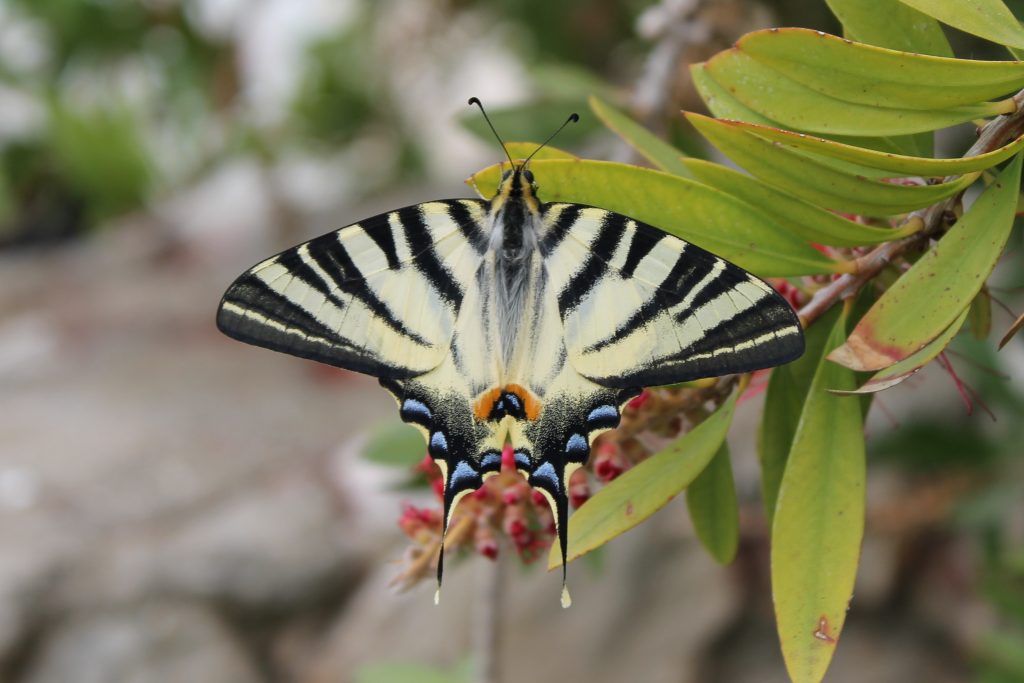
Swallowtail buttery displaying its bilateral symmetry
Types of Symmetry in Nature
Here are three common forms of symmetry to be found in nature:
- Reflective or bilateral symmetry. A good example of this is to be found in the wings of a butterfly. If you draw an imaginary line through the centre of a butterfly – from head to the tip of the abdomen – one side of the line will be a reflection of the other. The left wing mirrors the right wing.
- Rotional symmetry. This is to be found, for example, in the web spun by a spider. Rotational symmetry is where a shape or pattern can be rotated or turned around a point and it still looks the same. Sea Urchins begin with bilateral symmetry then grow into five-segmental rotational symmetry. Snowflakes have six-point rotational symmetry.
- Translational symmetry. This is where one shape is repeated in an object to make a symmetrical pattern. For example, hexagon shapes are repeated in a honeycomb. This is also known as modular symmetry. In a pinecone, the shape of each scale is repeated, resulting in translational symmetry.
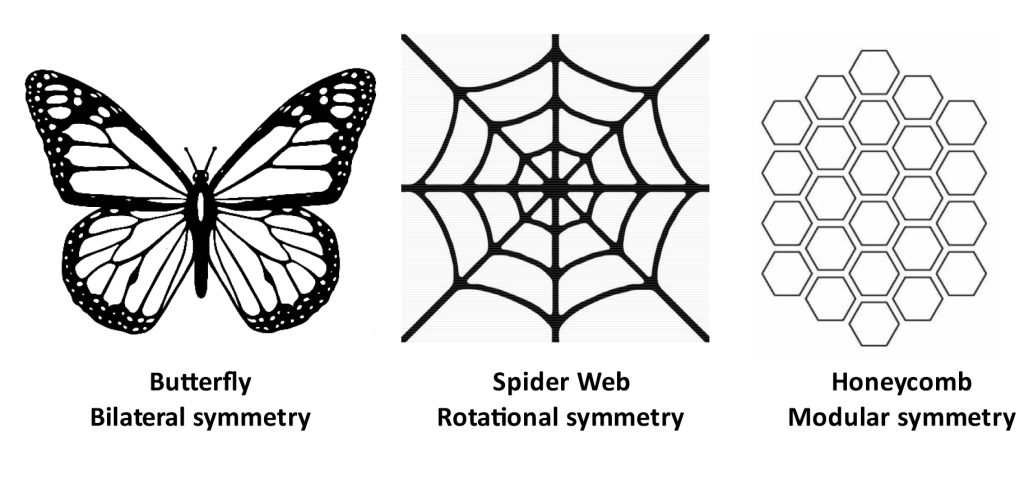
There are other forms of symmetry, like the repetition of bands on some species of snake.
Why Symmetry?
Before we turn to look at the question of ‘why symmetry?’, it is worth noting that there are lots of examples of fauna and flora that display apparent asymmetry. Although William Blake talked of a tiger’s ‘fearful symmetry’, tigers don’t have symmetrical designs on them – the stripes on one side of a tiger can be different from the stripes on the other side. (Blake was actually talking about a Godly-created symmetry between the gentle and the fearsome.) Perhaps a better illustrative case of asymmetry is the Fiddler Crab, which has one huge claw and one much smaller claw. Despite these examples, symmetry dominates in natural forms – from the gigantic Blue Whale down to the microscopic molecular level. Why should this be? Why is the natural world overwhelmingly symmetrical in its forms?
To answer this question, let’s remind ourselves of the basic principles of evolution. Evolution operates in two stages:
- Firstly, a genetic mutation causes a variation in a physical characteristic or trait
- Secondly, natural selection causes some characteristics or traits to dominate over others
Early theories of the predominance of symmetry in nature claimed that symmetry must bring evolutionary benefits – sturdiness of structure, efficiency of movement and speed, etc. – and, thus, natural selection has caused symmetry to predominate. This theory is now considered insufficient. To begin with, it is based upon a rather teleological interpretation of evolution which ‘foresees’ future benefits. Perhaps more importantly, such explanations fail to fully appreciate processes in the first stage of evolution, listed above.
There is scientific evidence to suggest that the first stage of evolution – the emergence of variation – is strongly biased towards forms that are symmetrical. According to Oxford University researchers: “small biological structures, proteins, RNA and signalling networks adopt algorithmically simple structures” [1]. Symmetrical shapes constitute algorithmically simple structures. Let’s look at an analogy. Consider if you were tiling a floor and I had to provide you with detailed instructions where to put each of the individual 600 tiles required. This would be a highly cumbersome and complex list of instructions. However, what if I was to say “lay one tile in the left-hand corner, lay another tile next to it, and another tile below it; then repeat for the remaining tiles”? This is a much simpler instruction and it would result in a symmetrical pattern. When genetic variation occurs at a cellular level these are much more likely to be simple structures resulting from simple genetic instructions, rather than complex structures resulting from complex genetic instructions. Symmetrical shapes and structures suit this proclivity.
So, before evolution begins to naturally select traits that will come to characterise a particular natural entity, particular biological micro-structures must first present themselves to the process of selection, or deselection. Following the argument laid out above, such biological micro-structures are highly likely to be symmetrical in form.
Symmetry as an aid to detection
Let’s imagine someone told you there were some interesting insects in a bush; micro-moths or small beetles. As we know, many insects use dull colours and cryptic patterns to hide from sight. How would you find the insects when quickly scanning the bush? The job isn’t going to be easy, especially if the insects are small and stationary. Quickly scanning a mass of leaves, especially when lots of leaves have specks and blemishes on them, might soon leave your sight and your brain boggled. Those who have a good eye for finding small insects in bushes will be looking for something that is different and of the appropriate size, but will also be looking for something else – symmetry. A speck, blemish, or a part of a plant that has fallen onto a leaf will look different, but it is less likely to appear symmetrical. By contrast, the insect you are looking for will have symmetry in its shape. There it is, I’ve found a small moth: different, appropriate in size, and displaying symmetry.
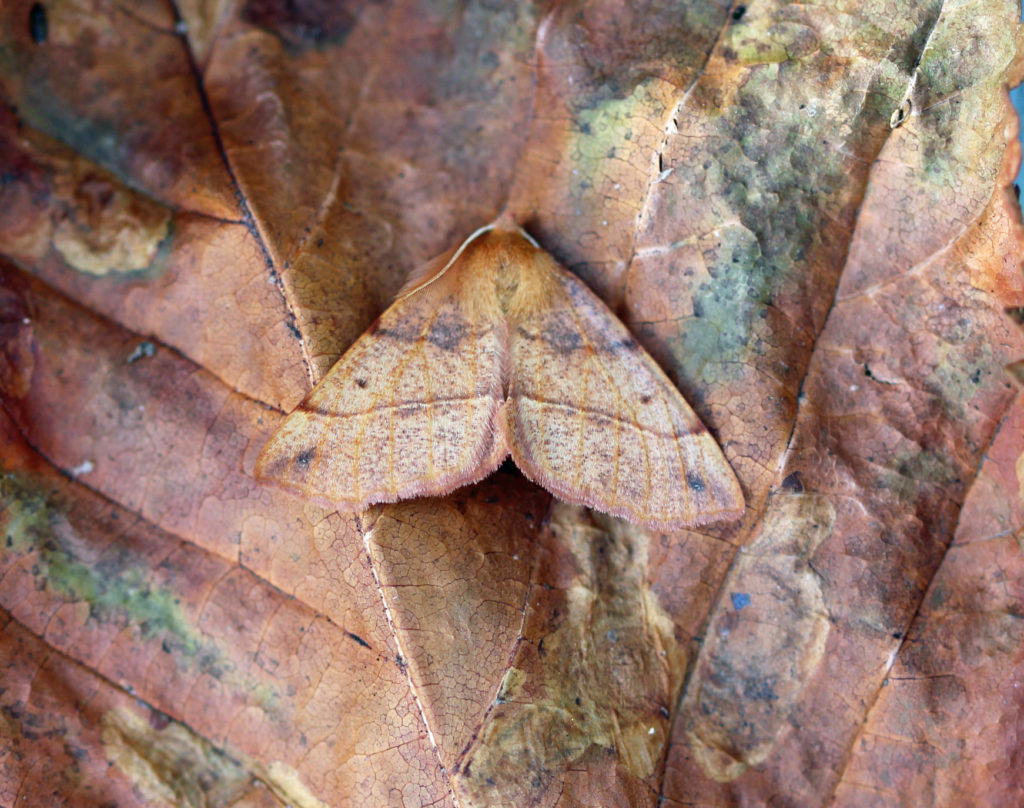
Feathered Thorn – camoflage (just) betrayed by symmetry
Humans are good at detecting and appreciating symmetry, but what about other creatures? There is strong evidence that even organisms with comparatively small nervous systems (such as bees) can detect symmetry, and favour symmetrical over asymmetrical patterns (say in flowers) [2]. When predators (such as warblers or wasps) are searching for invertebrate prey, there will be a number of clues that aid their search. One of these clues is likely to be symmetry. A symmetrical shape is likely to be an invertebrate, whereas an asymmetrical shape may be a small sliver of wood or a blemish on a leaf. Symmetry may be dominant in nature, but often it doesn’t necessarily aid survival from predation.
In the processes of the second stage of evolution – the development of the phenotype – natural selection sometimes favours those species that are able to disguise their symmetry. There are a number of ways that this has occurred in nature. Let’s look at some examples from the world of insects:
- Revealing asymmetrical aspects of the insect’s structure. Though bilateral symmetry exists, and could be obvious from one perspective (say from above), an insect can adopt a posture that reveals a strong degree of asymmetry when viewed from a different perspective (say from the side). Most butterflies rest with closed wings that often have asymmetric and cryptic patterns on the underside. Treehoppers often have bizarre projections that are highly asymmetrical from a side-on perspective. This strategy is more effective when the ‘top-down’ shape along the line a symmetry is much narrower than the ‘side-on’ asymmetrical shape (as it clearly would be in, say, a ‘Dead Leaf Butterfly’).
- Shifting symmetry from the midline. Butterflies and moths have bilateral symmetrical camouflage; i.e. the body can be divided along a midline and the pattern is a mirror image on each side. Studies have shown that the closer the symmetry is to the midline, the more visible it is to predators. Using predation experiments and image analysis, a new study, led by Bristol’s School of Biological Science, provides insights into how camouflaged prey have evolved to reduce the cost of this symmetry by shifting their salient patterns away from this midline [3].
- Covering symmetry. Some insects, in their larval stage, hide their symmetry by covering themselves with pieces of organic or inorganic materials in a random and asymmetrical manner. The larva of Bagworm moths are one example and Caddisfly larva are another.
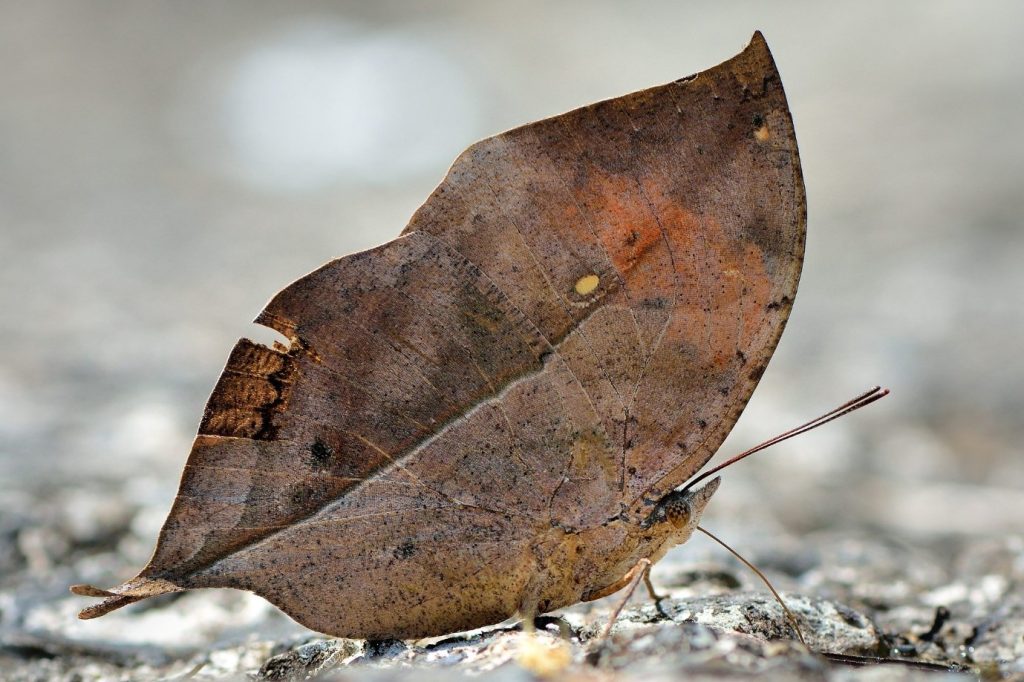
Dead Leaf Butterfly 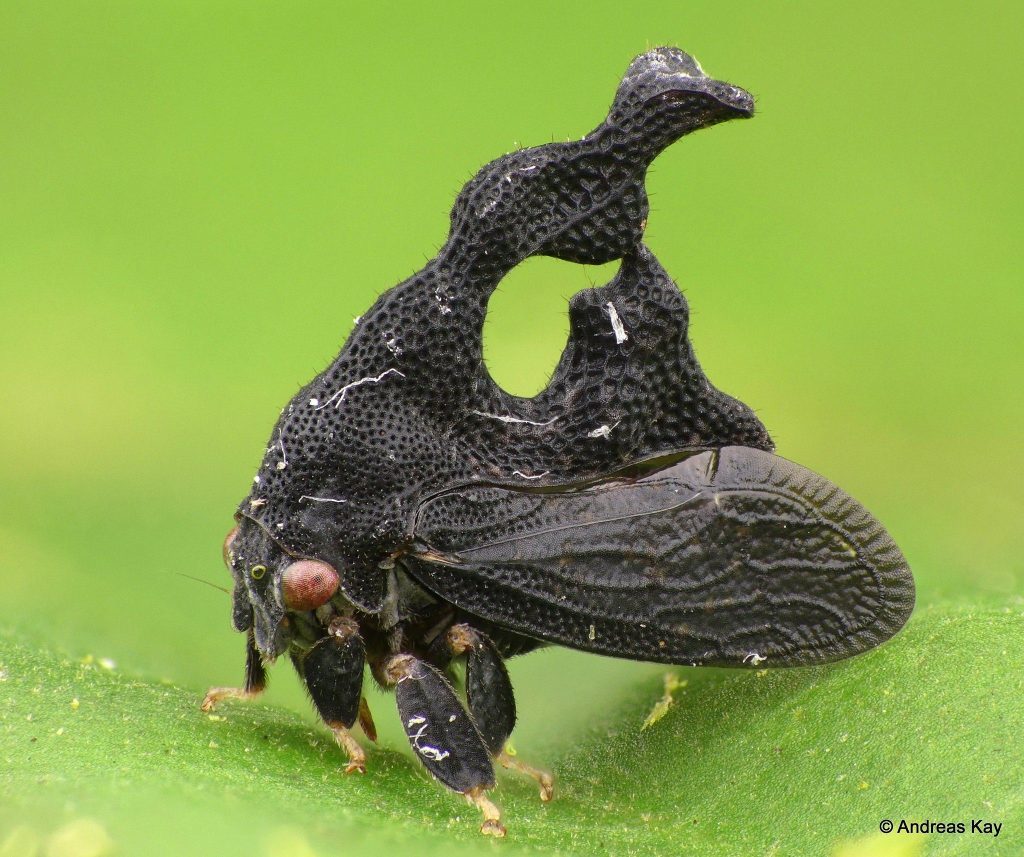
Treehopper – Cladonata Sp. 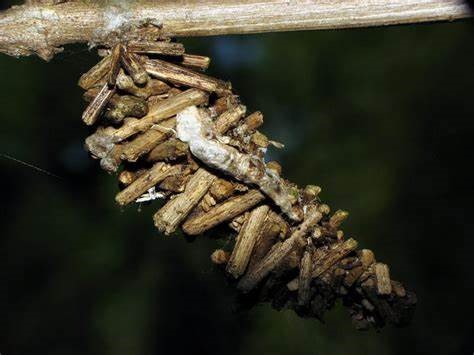
Bagworm larva
In summary and to-date, that is the story of symmetry, and asymmetry, in nature. Much of the research on this topic is recent, and I strongly suspect that we haven’t heard the end of the story.
[1] Johnson, I.G., Dingle, K., Greenbury, S.F. & Louis, A.A. (2022) ‘Symmetry and simplicity spontaneously emerge from the algorithmic nature of evolution.’ Proceedings of the National Academy of Sciences https://doi.org/10.1073/pnas.2113883119
[2] Giufa, M., Eichmann, B. & Menzel, R. (1996) ‘Symmetry perception in insects’ Nature 382(6590) 435-461 Symmetry perception in an insect – PubMed
[3] Wainwright, J.B., Scott-Samuel, N.E. & Cuthill, I.C. (2020) ‘Overcoming the detectability costs of symmetrical coloration’ National Library of Medicine https://doi.org/10.1098/rspb.2019.2664
Images of Swallowtail butterfly and Feathered Thorn moth by the author. Credits for other images: Dead Leaf Butterfly – Australian Geographic; Cladonata Sp Treehopper – Andreas Kay; Bagworm larva – ar.inspiredpencil.com

